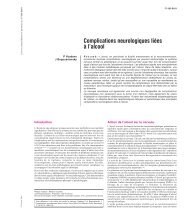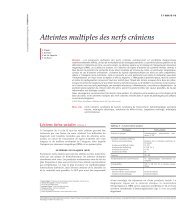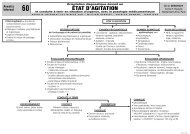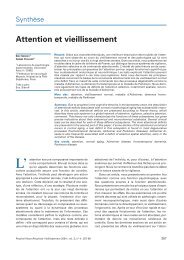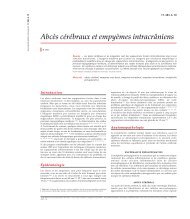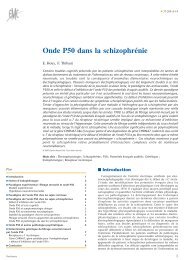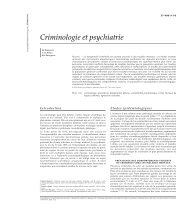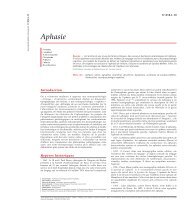Physiopathologie de l'ischémie cérébrale - Psychologie - M. Fouchey
Physiopathologie de l'ischémie cérébrale - Psychologie - M. Fouchey
Physiopathologie de l'ischémie cérébrale - Psychologie - M. Fouchey
Create successful ePaper yourself
Turn your PDF publications into a flip-book with our unique Google optimized e-Paper software.
Neurologie <strong>Physiopathologie</strong> <strong>de</strong> l’ischémie <strong>cérébrale</strong> 17-045-A-80<br />
Conclusion<br />
D’importants progrès ont été réalisés dans le domaine <strong>de</strong> la<br />
physiopathologie <strong>de</strong> l’ischémie <strong>cérébrale</strong>, en particulier à partir <strong>de</strong>s<br />
données expérimentales. Les mécanismes cellulaires et moléculaires<br />
mis en jeu sont ainsi mieux connus. Les travaux <strong>de</strong> ces <strong>de</strong>rnières<br />
années ont confirmé la multiplicité <strong>de</strong> ces mécanismes, leur intrication<br />
ainsi que leur caractère évolutif. Face à cette complexité, l’échec <strong>de</strong>s<br />
traitements neuroprotecteurs lors <strong>de</strong>s essais thérapeutiques est plus<br />
facilement compréhensible. Les perspectives thérapeutiques <strong>de</strong>meurent<br />
cependant importantes dans la mesure où <strong>de</strong> nombreuses voies n’ont<br />
pas encore ou très peu été explorées. Parmi celles-ci, les mécanismes<br />
impliqués dans la régénérescence <strong>de</strong>s tissus nerveux et vasculaires<br />
cérébraux tels que le recrutement <strong>de</strong> progéniteurs cellulaires au sein <strong>de</strong><br />
la moelle osseuse [43, 100] [72, 91]<br />
ou l’implication <strong>de</strong>s facteurs <strong>de</strong> croissance<br />
pourraient ouvrir d’intéressantes perspectives. De même, la mise au<br />
point d’agents pharmacologiques capables d’induire le développement<br />
[16, 25,<br />
d’une neuroprotection préventive chez <strong>de</strong>s patients à haut risque<br />
33] pourrait s’avérer particulièrement intéressante dans la perspective<br />
<strong>de</strong> limiter la sévérité et donc le handicap consécutif à un infarctus<br />
cérébral qui surviendrait en dépit <strong>de</strong>s traitements <strong>de</strong> prévention<br />
habituels. La mise au point <strong>de</strong> nouveaux agents thérapeutiques dans le<br />
domaine <strong>de</strong> l’ischémie <strong>cérébrale</strong> nécessite <strong>de</strong> revoir complètement les<br />
notions classiques <strong>de</strong> neuroprotection ainsi que les modalités et les<br />
délais d’administration <strong>de</strong>s traitements. Afin <strong>de</strong> faciliter la mise au<br />
point <strong>de</strong> ces nouveaux traitements et d’éviter l’écueil <strong>de</strong>s résultats<br />
négatifs <strong>de</strong>s étu<strong>de</strong>s cliniques, il conviendrait enfin <strong>de</strong> parfaire les<br />
connaissances <strong>de</strong> la physiopathologie <strong>de</strong>s infarctus cérébraux en<br />
pathologie humaine. Gageons que le développement <strong>de</strong>s techniques<br />
d’imagerie comme l’IRM <strong>de</strong> diffusion et la spectroscopie IRM<br />
permettra <strong>de</strong> telles avancées [67] .<br />
Références<br />
[1] Ayata C, Ropper AH. Ischaemic brain oe<strong>de</strong>ma. J Clin Neurosci<br />
2002;9:113-124<br />
[2] Baron JC. Mapping the ischaemic penumbra with PET:<br />
implications for acute stroke treatment. Cerebrovasc Dis<br />
1999;9:193-201<br />
[3] Barone FC, Feuerstein GZ. Inflammatory mediators and<br />
stroke: new opportunities for novel therapeutics. J Cereb<br />
Blood Flow Metab 1999 ; 19 : 819-834<br />
[4] Basti<strong>de</strong> M, Bor<strong>de</strong>t R, Pu Q, Robin E, Puisieux F, Dupuis B.<br />
Relationship between inward rectifier potassium current<br />
impairment and brain injury after cerebral<br />
ischemia/reperfusion. J Cereb Blood Flow Metab 1999;19:<br />
1309-1315<br />
[5] Becker KJ. Targeting the central nervous system inflammatory<br />
response in ischemic stroke. Curr Opin Neurol 2001 ;<br />
14 : 349-353<br />
[6] Beckman JS, Beckman TW, Chen J, Marshall PA, Freeman<br />
BA. Apparent hydroxyl radical production by peroxynitrite:<br />
implications for endothelial injury from nitric oxi<strong>de</strong><br />
and superoxi<strong>de</strong>. Proc Natl Acad Sci 1990 ; 87 : 1620-1624<br />
[7] Benchoua A, Guegan C, Couriaud C, Hosseini H, Sampaio<br />
N, Morin D et al. Specific caspase pathways are activated in<br />
the two stages of cerebral infarction. J Neurosci 2001;21:<br />
7127-7134<br />
[8] Bogousslavsky J, Garazi S, Jeanrenaud X, Aebischer N, Van-<br />
Melle G. Stroke recurrence in patients with patent foramen<br />
ovale:theLausanneStudy.LausanneStrokewithParadoxal<br />
Embolism Study Group. Neurology1996 ; 46 : 1301-1305<br />
[9] Bogousslavsky J, Regli F. Unilateral watershed infarcts.Neurology<br />
1986 ; 36 : 373-377<br />
[10] Bonfoco E, Krainc D, Ankarcrona M, Nicotera P, Lipton SA.<br />
Apoptosis and necrosis: two distinct events induced,<br />
respectively, by mild and intense insults with N-methyl-Daspartate<br />
or nitric oxi<strong>de</strong>/superoxi<strong>de</strong> in cortical cell culture.<br />
Proc Natl Acad Sci 1995 ; 92 : 7162-7166<br />
[11] Bonita R. Epi<strong>de</strong>miology of stroke. Lancet 1992 ; 339 :<br />
342-344<br />
[12] Boulu RG. Régulation <strong>de</strong> la circulation <strong>cérébrale</strong>. Lett Pharmacol<br />
1995;9:159-163<br />
[13] BrüneB,VonKnethenA,SandauKB.Nitricoxi<strong>de</strong>anditsrole<br />
in apoptosis. Eur J Pharmacol 1998 ; 351 : 261-272<br />
[14] Busija DW, Heistad DD. Factors involved in the physiological<br />
regulation of the cerebral circulation. Rev Physiol<br />
Biochem Pharmacol 1984 ; 101 : 162-211<br />
[15] ChanPK.Reactiveoxygenradicalsinsignalinganddamage<br />
in the ischemic brain. J Cereb Blood Flow Metab 2001;21:<br />
2-14<br />
[16] Chen J, Simon R. Ischemic tolerance in the brain. Neurology<br />
1997 ; 48 : 306-311<br />
[17] Chopp M, Li Y, Jiang N, Zhang RL, Prostak J. Antibodies<br />
against adhesion molecules reduce apoptosis after transient<br />
middle cerebral artery occlusion in rat brain. J Cereb<br />
Blood Flow Metab 1996 ; 16 : 578-584<br />
[18] Cipolla MJ, Lessov N, Clark WM, Haley EC Jr. Postischemic<br />
attenuation of cerebral artery reactivity is increased in the<br />
presence of tissue plasminogen activator. Stroke 2000;31:<br />
940-945<br />
[19] Cipolla MJ, McCall AL, Lessov N, Porter JM. Reperfusion<br />
<strong>de</strong>creases myogenic reactivity and alters middle cerebral<br />
artery function after focal cerebral ischemia in rats. Stroke<br />
1997 ; 28 : 176-180<br />
[20] Connolly ES Jr, Winfree CJ, Springer TA, Naka Y, Liao H, Yan<br />
SD et al. Cerebral protection in homozygous null ICAM-1<br />
mice after middle cerebral artery occlusion. Role of neutrophil<br />
adhesion in the pathogenesis of stroke. J Clin Invest<br />
1996 ; 97 : 209-216<br />
[21] Cook DA. Mechanisms of cerebral vasospasm in subarachnoid<br />
haemorrhage. Pharmacol Ther 1995 ; 66 : 259-284<br />
[22] Cupini LM, Diomedi M, Placidi F, Silvestrini M, Giacomini<br />
P. Cerebrovascular reactivity and subcortical infarctions.<br />
Arch Neurol 2001 ; 58 : 577-581<br />
[23] De Caterina R, Libby P, Peng HB, Thannickal VJ, Rajavashisth<br />
TB, Gimbrone MA Jr et al. Nitric oxi<strong>de</strong> <strong>de</strong>creases<br />
cytokine-induce<strong>de</strong>ndothelialactivation.Nitricoxi<strong>de</strong>selectively<br />
reduces endothelial expression of adhesion molecules<br />
and proinflammatory cytokines. J Clin Invest 1995 ;<br />
96 : 60-68<br />
[24] Del Zoppo GJ, Schmid-Schonbein GW, Mori E, Copeland<br />
BR, Chang CM. Polymorphonuclear leukocytes occlu<strong>de</strong><br />
capillaries following middle cerebral artery occlusion and<br />
reperfusion in baboons. Stroke 1991 ; 22 : 1276-1283<br />
[25] Deplanque D, Basti<strong>de</strong> M, Bor<strong>de</strong>t R. Ischaemic preconditioning<br />
of the endothelium and smooth muscle of cerebral<br />
arteries. Trends Pharmacol Sci 2000 ; 21 : 332-333<br />
[26] Deplanque D, Puisieux F, Bor<strong>de</strong>t R. Les modèles expérimentaux<br />
d’ischémie-reperfusion <strong>cérébrale</strong>. Sang Thromb<br />
Vaiss 1999 ; 11 : 471-478<br />
[27] Dirnagl U, Ia<strong>de</strong>cola C, Moskowitz MA. Pathobiology of<br />
ischaemic stroke: an integrated view. Trends Neurosci<br />
1999 ; 22 : 391-397<br />
Que retenir ?<br />
Le cerveau est protégé <strong>de</strong> l’hypoperfusion jusqu’à un certain point<br />
par un réseau anastomotique complexe et la possibilité d’une<br />
autorégulation du débit sanguin cérébral.<br />
L’occlusion artérielle à l’origine <strong>de</strong> l’infarctus peut résulter <strong>de</strong><br />
causes diverses mettant en jeu <strong>de</strong>s mécanismes emboliques,<br />
hémodynamiques, l’atteinte sélective <strong>de</strong>s petites artères<br />
perforantes ou le vasospasme.<br />
Bien que plus constants, les mécanismes cellulaires et moléculaires<br />
développés au cours <strong>de</strong> l’ischémie <strong>cérébrale</strong> sont, quant à eux,<br />
variables dans le temps et leur localisation.<br />
La nécrose cellulaire, qui survient au cœur <strong>de</strong> la zone ischémiée,<br />
apparaît précocement et résulte <strong>de</strong> la toxicité du calcium, du<br />
glutamate et <strong>de</strong>s phénomènes <strong>de</strong> dépolarisation.<br />
Les mécanismes délétères tardifs résultent <strong>de</strong> la modulation <strong>de</strong> la<br />
transcription <strong>de</strong> nombreux gènes, principalement au sein <strong>de</strong> la<br />
zone <strong>de</strong> pénombre, avec pour conséquence le développement <strong>de</strong><br />
processus inflammatoires et <strong>de</strong> l’apoptose.<br />
Dans certaines conditions, la reperfusion peut avoir plus d’effets<br />
délétères que favorables.<br />
L’échec <strong>de</strong>s traitements <strong>de</strong> neuroprotection peut s’expliquer en<br />
partie par l’inadéquation <strong>de</strong>s modèles et <strong>de</strong>s métho<strong>de</strong>s<br />
d’évaluation développés chez l’animal ainsi que par la mise en jeu<br />
séparée <strong>de</strong>s voies moléculaires impliquées dans les lésions<br />
neuronales.<br />
Une meilleure connaissance <strong>de</strong>s mécanismes, en particulier chez<br />
l’homme, et la prise en compte <strong>de</strong>s mécanismes cellulaires tardifs<br />
pourraient permettre le développement <strong>de</strong> thérapeutiques plus<br />
efficaces.<br />
[28] Dobkin BH, Choi DW. Selective vulnerability of the brain:<br />
new insights into the pathophysiology of stroke. Ann Int<br />
Med 1989 ; 110 : 992-1000<br />
[29] Ellison JA, Barone FC, Feuerstein GZ. Matrix remo<strong>de</strong>ling<br />
after stroke. De novo expression of matrix proteins and<br />
integrin receptors. Ann NY Acad Sci 1999 ; 890 : 204-222<br />
[30] Endres M, Laufs U, Huang Z, Nakamura T, Huang P, Moskowitz<br />
MA et al. Stroke protection by 3-hydroxy-3methylglutaryl<br />
(HMG)-CoA reductase inhibitors mediated<br />
by endothelial nitric oxi<strong>de</strong> synthase. Proc Natl Acad Sci<br />
1998 ; 95 : 8880-8885<br />
[31] Fagni L, Olivier M, Lafon-Cazal M, Bockaert J. Involvement<br />
of divalent ions in the nitric oxi<strong>de</strong>-induced blocka<strong>de</strong> of<br />
N-methyl-D-aspartatereceptorsincerebellargranulecells.<br />
Mol Pharmacol 1995 ; 47 : 1239-1247<br />
[32] Fisher CM. Lacunar strokes and infarcts: a review. Neurology<br />
1982 ; 32 : 871-876<br />
[33] Fisher M, Jonas S, Sacco RL. Prophylactic neuroprotection<br />
to improve stroke outcome. Cerebrovasc Dis 1994 ;<br />
4 (suppl 4) : 20-23<br />
[34] Fisher M, Meiselman HJ. Hemorheological factors in cerebral<br />
ischemia. Stroke 1991 ; 22 : 1164-1169<br />
[35] Forster C, Clark HB, Ross ME, Ia<strong>de</strong>cola C. Inducible nitric<br />
oxi<strong>de</strong> synthase expression in human cerebral infarcts. Acta<br />
Neuropathol 1999 ; 97 : 215-220<br />
[36] Giroud M, Milan C, Beuriat P, Gras P, Essayagh E, Arvreux P<br />
et al. Inci<strong>de</strong>nce and survival rates during a two-year period<br />
of intracerebral and sub-arachnoid haemorrhages, cortical<br />
infarcts, lacunes and transient ischemic attacks: the Stroke<br />
Registry of Dijon,1985-1989. Int J Epi<strong>de</strong>miol 1991;20:<br />
892-899<br />
[37] Gladstone DJ, Black SE, Hakim AM. Toward wisdom from<br />
failure: lessons from neuroprotective stroke trials and new<br />
therapeutic directions. Stroke 2002 ; 33 : 2123-2136<br />
[38] Graham SH, Chen J. Programmed cell <strong>de</strong>ath in cerebral<br />
ischemia. J Cereb Blood Flow Metab 2001 ; 21 : 99-109<br />
[39] Gross SS, Wolin MS. Nitric oxi<strong>de</strong>: pathophysiological<br />
mechanisms. Annu Rev Physiol 1995 ; 57 : 737-769<br />
[40] Gross WL, Bak MI, Ingwall JS, Arstall MA, Smith TW, Balligand<br />
JL et al. Nitric oxi<strong>de</strong> inhibits creatine kinase and regulates<br />
rat heart contractile reserve. Proc Natl Acad Sci 1996 ;<br />
93 : 5604-5609<br />
[41] Hallenbeck JM, Dutka AJ. Background review and current<br />
concepts of reperfusion injury. Arch Neurol 1990;47:<br />
1245-1254<br />
9



